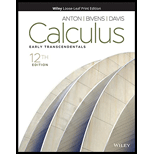
(a) We will see later that the polynomial
(b) Try to confirm your conjecture using the limit comparison test
Want to see the full answer?
Check out a sample textbook solution
Chapter 9 Solutions
Calculus: Early Transcendentals
Additional Math Textbook Solutions
Using and Understanding Mathematics: A Quantitative Reasoning Approach (6th Edition)
Elementary Statistics: Picturing the World (7th Edition)
Graphical Approach To College Algebra
A Problem Solving Approach To Mathematics For Elementary School Teachers (13th Edition)
- Let f(x, y) = 2x + 3y+ In(xy)arrow_forward(3) (16 points) Let D = [0, π/2] × [0, 7/6]. Define T: DCR2 R3 by → T(0, 4) = (2 sin cos 0, 2 sin sin 0, 2 cos x). Let S be the surface parametrized by T. (a) (8 points) Determine the normal, call it n(p), for the tangent plane TS at an arbitrary point p = T(0, 4). (b) (4 points) Show that n(p) parallel to the position vector T(0, 4) determined by p? Do the two vectors have the same direction or opposite direction? Explain. (c) (4 points) At which points p, if any, is TS parallel to the xy-plane?arrow_forward5:19 0 TEMU TEMU >>> 49 95% University at Albany - Single Sig... L Lumen OHM D2L HW4- AMAT100-Precal HW4 Score: 12.99/21 Answered: 18/21 × Question 16 Score on last try: 0 of 1 pts. See Details for more. > Next question Get a similar question You can retry this question below Find the inverse for the function k(x) = √√7x+12 k-¹(x) = Question Help: Video Message instructor Submit Question esc ||| F1 80 ୮ (x) = tarrow_forward
- Algebra & Trigonometry with Analytic GeometryAlgebraISBN:9781133382119Author:SwokowskiPublisher:Cengage
